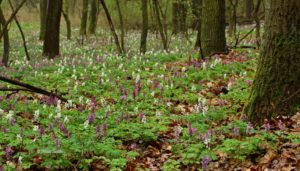General description of project area
Name of the project area: Kerecsendi-erdő
Surface area (ha): 118.020
EU protection status SPA: –
EU protection status SCI: NATURA 2000 Code HUBN20038
Other protection status according to national or regional legislation: Nationally protected area
The main uses of the project site: The main land uses: Nature Conservation 98%, forestry 2%
The ownership status: State property 98%, private 2%

Scientific description of project area
The project area is located in the transition zone of the Bükk mountain and the Great Plain where a mixed lowland and hill wildlife exist. The area is dominated by 91I0 * Euro-Siberian steppic woods with Quercus spp. (58%) and91G0*Pannonic woods with Quercus petraea and Carpinus betulus (25%).
There are some 91M0 Pannonian-Balkanic turkey oak –sessile oak forests (3%) too.
Some part of the 91I0 * Euro-Siberian steppic woods with Quercus spp. habitat is occupied by the invasive Robinia pseudoacacia (3%) and by the alien Quercus rubra (6%). Some 40A0 * Subcontinental peri-Pannonic scrub (4%) can also be found.
The most important plant species are the Dictamnus albus, Doronicum hungaricum, Iris graminea, I. Variegata, Pulsatilla grandis and Thlaspi jankae.
Animals of the area:
- Mammals: Dryomys nitedula,
- Birds: Dendrocopos major, Dryocopus martius, and Picus canus.
- Beetles: Cerambyx cerdo, and Lucanus cervus
- Butterflies: Dioszeghyana schmidtii
Importance of the project area for biodiversity and/or for the conservation of the species /habitat types targeted at regional, national and EU level
The project area with its specific location hosts nearly 450 vascular plants in different oak forest stands (91G0, 91I0, 91M0,) which are very important habitats of several strictly protected species listed in the scientific description part, hence a proper nature conservation management of the oak forests is required. Especially 91I0* Euro-Siberian steppic woods with Quercus spp. is very endangered because its national representation was reduced from the original 9% to 0,1% today. However, to be able to do this the private forest part must be purchased, the Quercus rubra plantation forest must be converted to 91I0* oak forest and the invasive species must be eliminated in the area. The stand structure, composition, mixture rate and dead wood of Euro-Siberian steppic woods with Quercus spp, Pannonic woods with Quercus petraea and Carpinus betulus, and Pannonian-Balkanic turkey oak – sessile oak forests of the area can be improved by the proper nature conservation management. These forests and the presence of Sub-Pannonic steppic grasslands makes the area important in biodiversity and EU point of view. The naturalness and biological diversity of the area can be relatively quickly improved by a proper nature conservation management.
Flagship species in project area
Dictamnus albus, Euphydryas maturna, Parnassius mnemosyne